This is a continuation of my previous post about my trip to Historic Hampi. After spending a few days in Hampi, we had visited most of the famous places and were ready to head back when we got into a conversation with Mr Sarath Champati, who is the Associate Director for Conservation and Experiences at Evolve Back Resorts. During the conversation he mentioned that they were in the process of preparing a new trail and had just come back from a walk through of the trail the day before. This was an place called ‘HireBenakal’ which hardly anyone knows about which has Dolmen’s dating back almost 3000 years, making it a megalithic site. Since both of us are quite interested in history we requested that we be allowed to accompany them on the trail and after reminding us that this trail was still under development and involved a lot of hiking they agreed to take us up to the site the next day. We immediately extended the stay by another day and crashed early since we had to wake up early morning to reach the place.

Ombatthugudda, Start of trail to site
The next day we started early (around 6am) and reached the starting point of the trail by 7:30am. If you don’t already know about it, it is hard to find this place as there are almost no signs or directions. I bookmarked the location on Google Maps, so if you are planning to go you can use this to navigate: Ombatthugudda, Start of trail to site. There is single guard over there who is basically there to prevent folks from trying to dig up the Dolmens. A few weeks before we visited some folks from the nearby villages damaged 3-4 of the structures while trying to dig under them because they thought that there would be buried treasure under them. That is not the case but still the damage was done and some priceless artifacts damaged by morons.
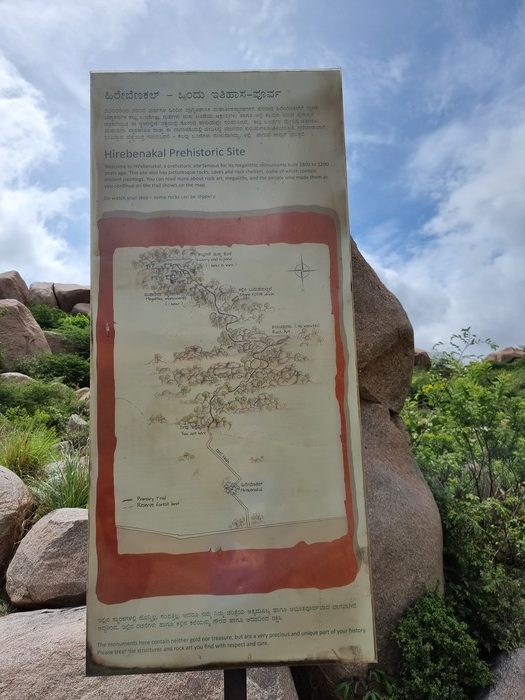
Overview of the Hirebenakal Prehistoric site and the trail
The trail up from the starting point is a wonderful trek, you get to see a lot of flora and fauna. Plus since not a lot of people come this way there is a high chance of spotting wild animals on the way. While we were walking up our guide suddenly asked us to stop and talk loudly. After a min or so he showed us a pile of fresh shit on the trail and explained that it was from a Sloth bear which we had interrupted in the middle of taking a dump. They have very bad eyesight but have excellent hearing so if you are walking along quietly and stumble on them they might attack as they wouldn’t see you from a distance. If you keep making noise while walking then they hear you and leave so as not to have an encounter. Which is what had happened in this case. He then told us that the bear had been feasting on Mango and other fruits down at the village and he tried showing us the remains in the poop. But I took him on his word and didn’t try to verify what he was saying.
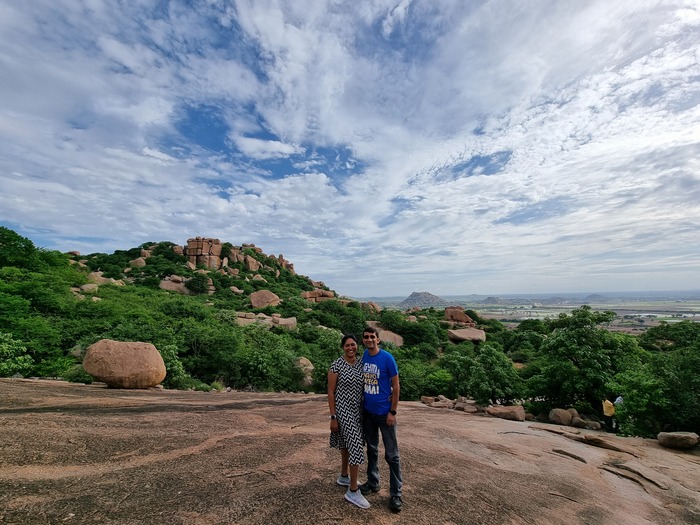
Fantastic view on the way
About a third of the way up we took a short detour (5 min hike off the main trail) and came to some really cool Rock Art which were dated to be more than 2000 years old. It is not clear why the paintings were done at these rocks but a popular theory is that they had something to do with religious ceremonies. There are about 10 rock shelters in the area which have these paintings.
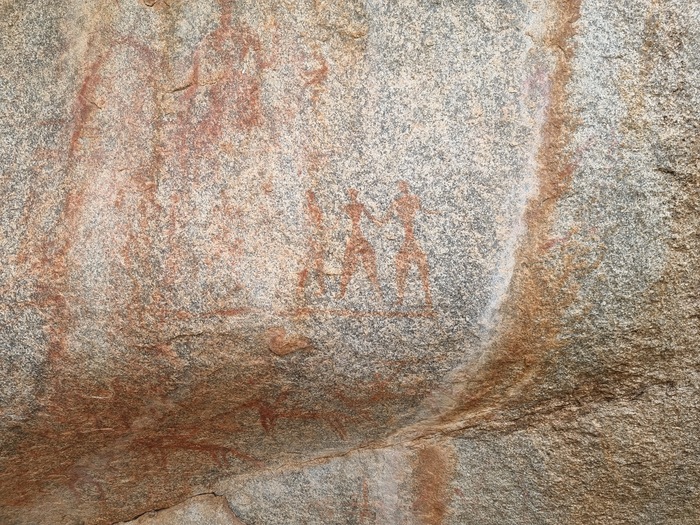
Over 2000 year old Rock Paintings
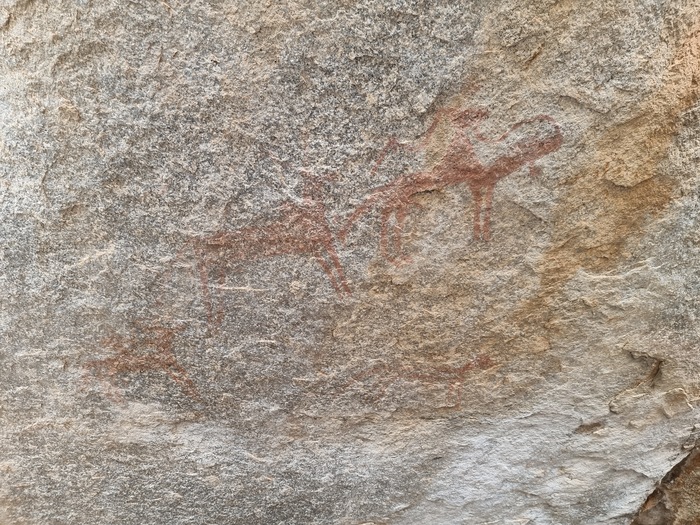
Some more rock paintings
At first it was hard to see the paintings as they look like rust or regular mud but when you get closer they suddenly take shape and you can see people, animals and other day to day activities painted on the rock. As this is not a often visited site there were no barriers stopping us from getting close to the paintings so with extreme care to avoid touching/damaging the paintings we got as close as we could (a few inches away at times) to check out the paintings. The paintings are done with natural paint called Red Ochre made by mixing powdered haematite (an iron ore) with water.
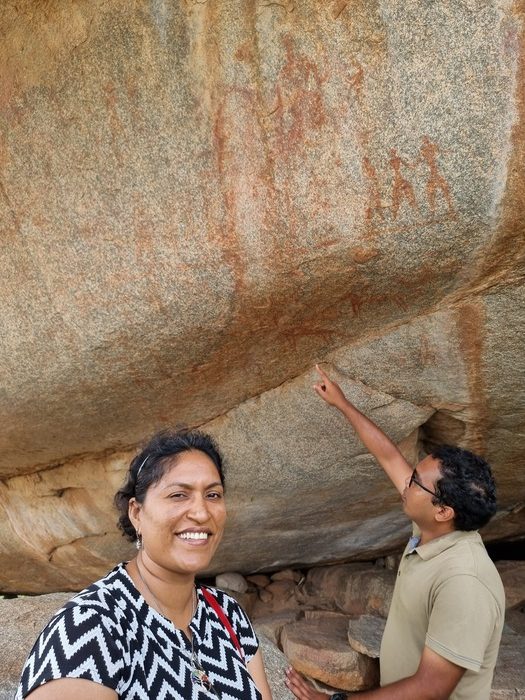
Mr. Vinay showing us the paintings
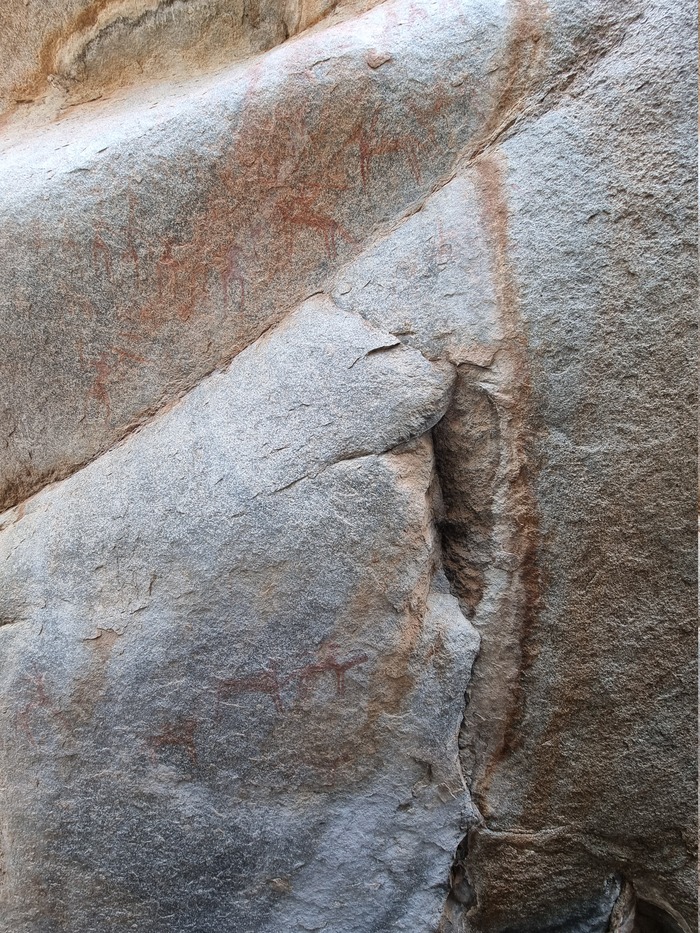
Some more paintings
Since the paintings are exposed to nature a lot of them have been erased by erosion over time. The only way to preserve them is to cover them with something that prevents natural elements from touching the paintings. Unfortunately that would be a massive undertaking and not something that can be done easily or cheaply. Which is why we need to put pressure on the government and the Archeological Society to take steps to preserve these artifacts for future generations.
After spending a little while admiring the paintings we started back up the trail and noticed a massive boulder on the way which looked like it was cut in half by a giant knife. One theory is that this rock acted as a waymarker and guide for the folks coming to visit the Dolmen’s, another is that it was used to warn people about attacks or to notify them about the start of important ceremonies etc. It was carved by hand without any power tools and I can only imagine the time and effort required to cut the rock in half so precisely using only stoneage tools.
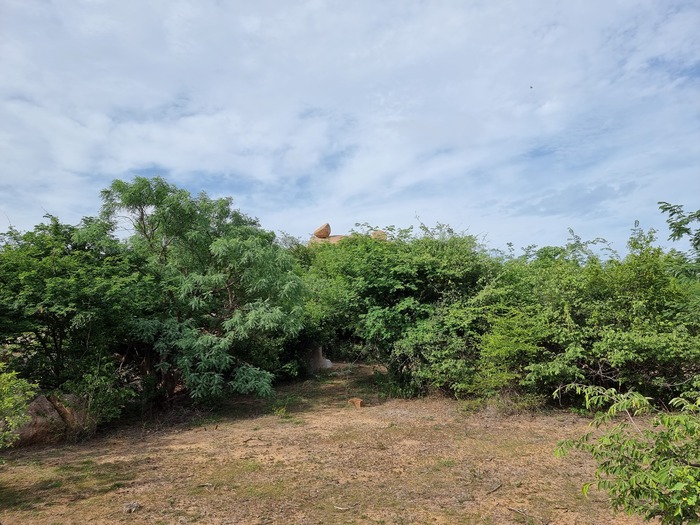
Stone kettledrum on the way to the site
Shortly after you see the rock signpost the trail flattens out and is a pleasant walk between trees and shrubs. Soon thereafter we started seeing Dolmens all around us. They started off as small structures about a foot in height and as you near the center they are massive structures over 10 feet high. One theory is that the central dolmens were for the chief’s or other important people in the tribe and the further you came out from the center the lesser the status of the people making the structures which translated into smaller structures that would be cheaper/easier to make. But again there is no way to know for sure why these were built or if any of the theories we are putting forward have any merit.
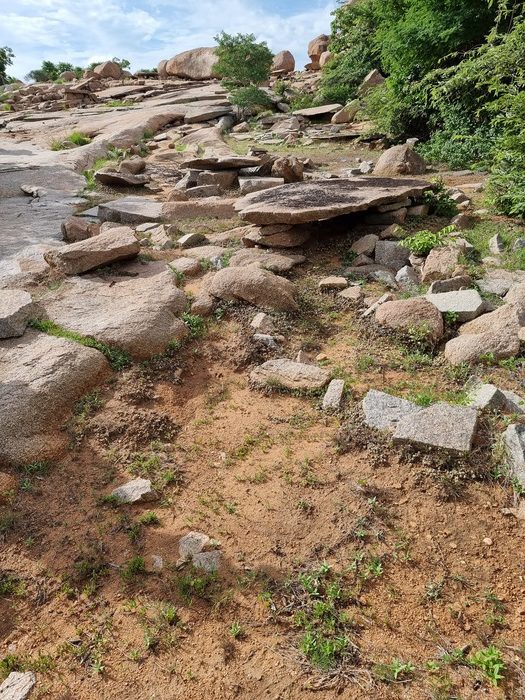
Tiny Dolmen’s near the outskirts of the site
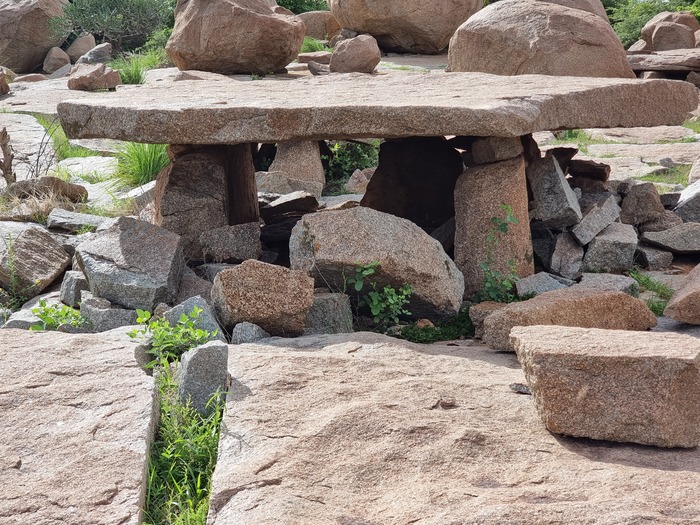
Slightly larger Dolmen found as we get closer to the center
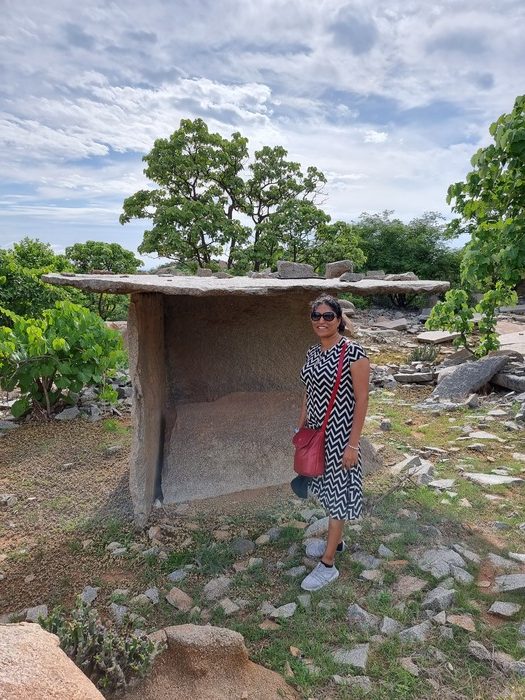
Dolmen’s getting larger as we get to the center
Dolmen’s are basically stone structures usually consisting of two or more vertical megaliths supporting a large flat horizontal capstone or “table”. They are found all over the world and are thought to be tombs or prayer places for ancestor worship. But no bodies have been found at any of the Dolmen’s around the world possibly because of the age and the fact that it looks like the bodies were left in the open inside them which would allow wild animals access to the bodies and over the years all evidence of them would be erased by time. One of the most famous examples of Dolmen is the Stonehenge in the UK but there are multiple sites in India with these structures as well.
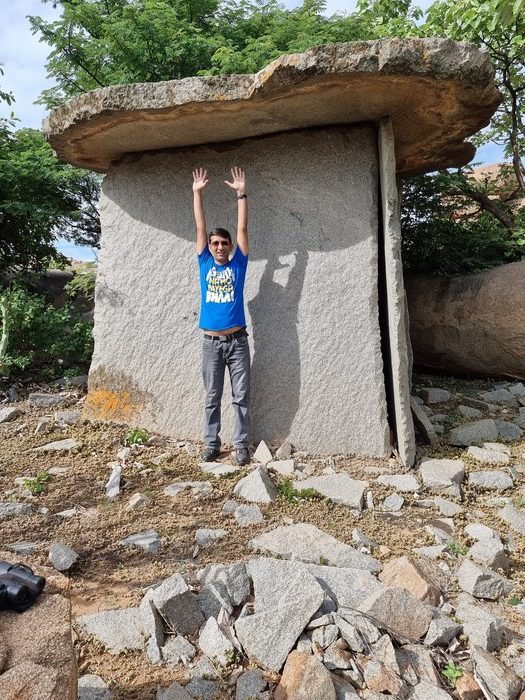
Gigantic Dolmens at the center of the site
This particular site started off with over 490 when it was first discovered by local herdsmen but due to damage and time only ~200 are still left standing. There are multiple kinds of Dolmen’s here starting with 3-sided chambers with a large capstone on the top allowing them to balance on each other. These are massive stone structures with each slab weighing several tons. It is hard to imagine the effort required to cut the slabs and then lift them up over 10-15 feet in the air while ensuring the ‘walls’ are stable and don’t collapse. Some of these structures have a porthole carved into one of the walls and they are perfectly circular. Imagine carving a hole in a 6-8 inch thick slab of rock while ensuring the hole is perfectly circular. It would be difficult to do so with modern power tools but these folks did it with hand tools.
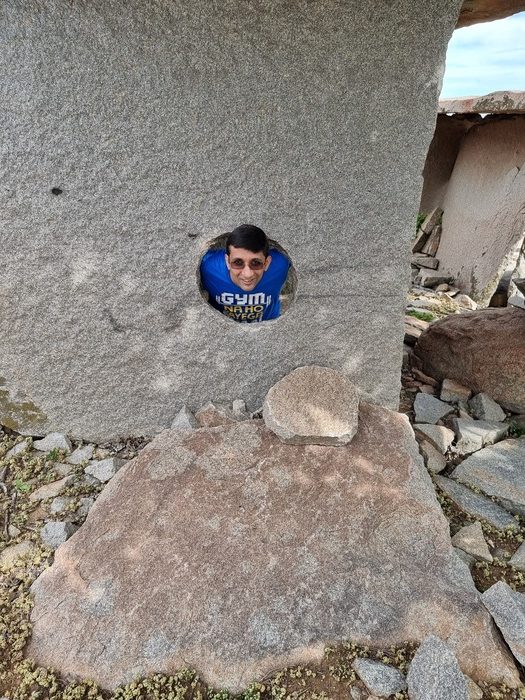
Circular hole carved in solid rock without power tools.
In addition to the 3 sided chambers, the site also has several buried and semi-buried dolmens called cists and dolmenoid cists along with irregular polygonal and rock shelter chambers. All of these were carved manually over the years. Near the center there is a massive water reservoir which is where archeologists think the tribes created the Red Ochre paint and one can see portions of the rock that are still colored red from the years of paint mixing.
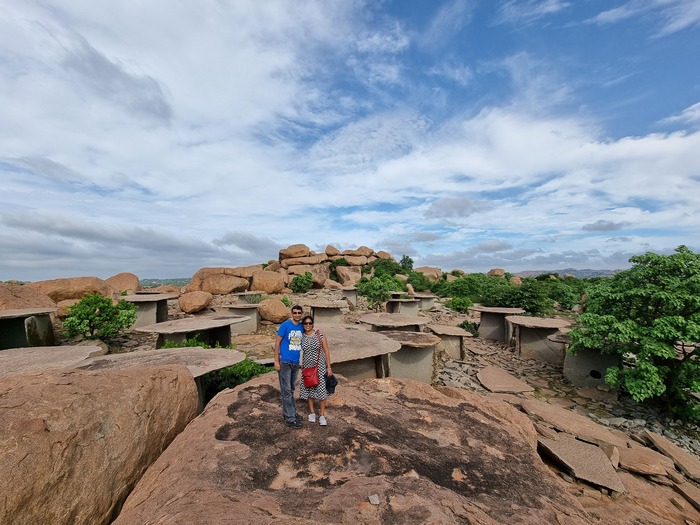
Photo with the dolmens in the background
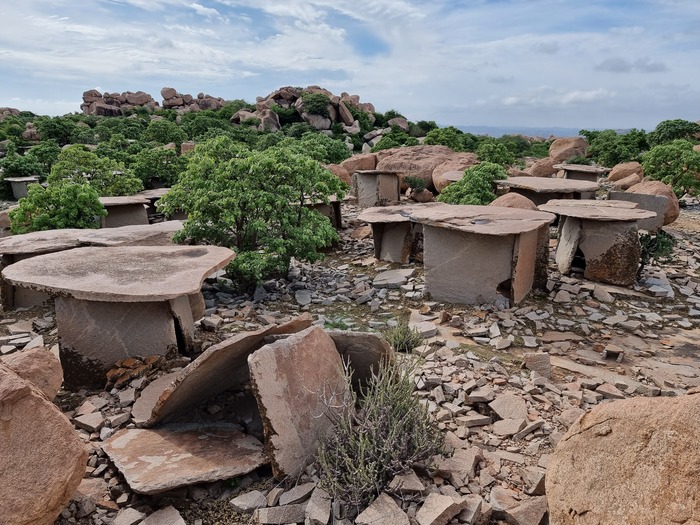
Shot of some of the Dolmens still standing after ~3000 years
As per the excavation and study done there, it doesn’t seem that people stayed here full time but rather came up from nearby villages to work on the structures. This supports the theory that the site had religious significance but as I said before it is almost impossible to confirm these theories since there is hardly any remains here. Which is one of the reasons idiots around the world dismiss the possibility that they were created by ancient humans. A popular theory is that Aliens came to earth and built these structures because humans couldn’t have done it. These theories are mostly sprouted by western ‘experts’ who can’t believe that indigenous people did what Europeans could not and thus try to discredit their work. Shows like Ancient Aliens and like don’t help either as they spread this racist theory that without ‘white man’ the natives couldn’t have created such works. These programs ignore the massive amount of supporting evidence that it is in-fact possible to create these structures with only muscle power and time. Similar theories abound about the pyramids and other ancient structures and all I can say to them is that, just because you couldn’t do it doesn’t mean that other cultures were not advanced enough and skillful enough to do it. Looking at what they did with stone-age tools it is humbling to imagine what they could have achieved if they had access to modern tools and resources.
Hirebenkal is one of the very few Indian megalithic sites found with associated habitations. In the nearby village archaeologists have unearthed rich cultural material, including pre-megalithic implements, iron slag, pottery of Neolithic, megalithic and early historic period. So it is sad to find it so neglected and poorly protected. There is ongoing effort to get the site classified as a UNESCO World Heritage Site. Hopefully it will happen soon and this amazing site will be preserved for future generations to admire.
After a couple of hours around the site, we started back and the trip down was a lot easier but a lot hotter (as it was quite sunny). We reached the start of the trek and had a quick breakfast there from the packed food that we had brought along. Once done with the food we headed back to the resort, where we relaxed for the rest of the day.
The next day, we had breakfast and started the drive back to Bangalore with a determination to try visit more such historical sites in India and spread awareness about them and our rich cultural history.
– Suramya